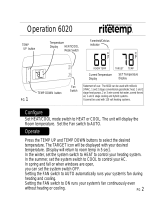
PG 8
PG 9
Caution
Special Thermostat Battery Cautions
Always replace the batteries as soon as the “Low Batt” ashes. The thermostat is a battery powered
device. You must be responsible to replace batteries before they run out. Failure to replace batteries can
result in overheating or excessive cooling of your house.
• Even if the “Low Batt” indicator does not ash, you should always replace the batteries at least once a
year. Replacing the batteries also helps to prevent leakage that can corrode and damage the thermostat.
• If you are leaving your home for a month or more, you should replace the batteries as a precaution
against battery failure in your absence.
• Always use new alkaline batteries.
• Failing to replace the batteries, when necessary,
could cause the thermostat to lose power or
malfunction. If the thermostat loses power, then the thermostat will not control the temperature which
could result in your HVAC system not functioning as you intended and lead to possible damage from
overheating or excessive cooling.
• If the thermostat batteries fail with the heat OFF, this can result in NO HEAT and possible frozen or
broken pipes and water damage.
• If the thermostat batteries fail with the cool OFF, this can result in NO COOL and could cause possible
damage or excessive temperatures.
BATTERY WARNING
Do Not Mix Old And New Batteries.
Do Not Mix Alkaline, Standard (Carbon - Zinc),
Or Rechargeable (Nickel - Cadmium) Batteries
DO NOT DISPOSE OF BATTERIES IN FIRE. BATTERIES
MAY EXPLODE OR LEAK.






















